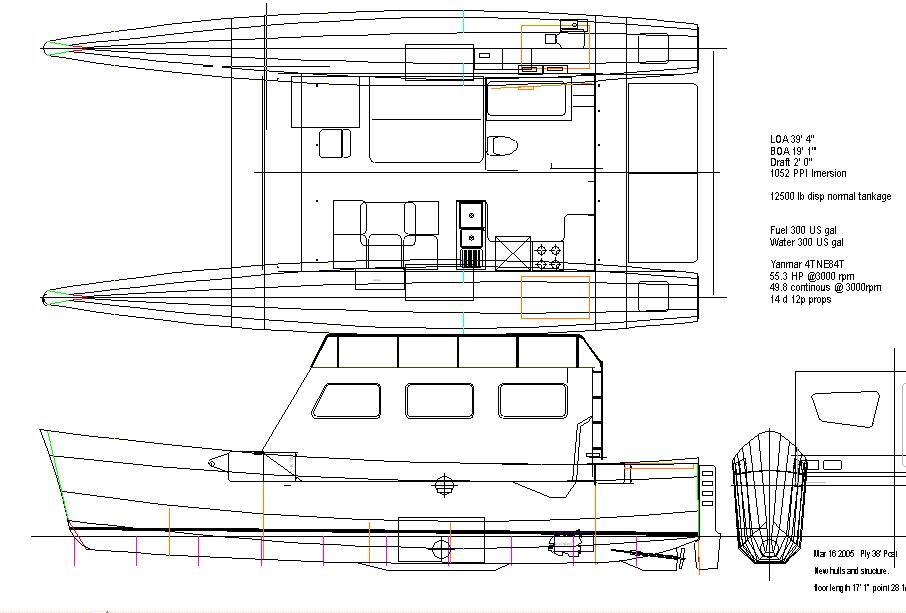

After the launch a number of problems were experienced.
Shaft slip:
The first was leaking of the starbord shaft log as soon as the engine was run up. This turned out to be caused by a slipage of the shaft forward in the thrust bearing which was of a taper lock type. The immediate fix on this was to cut an access hatch in the deck above the shaft log and adjust the dripless bearing bellows compression. The longer term fix was very difficult. I was not able to pull the shaft back from the taper lock. To prevent further sliping I used a collar around the saft that bore on the taper lock mount in the main bearing. To get back the clearance needed for the prop hub which was jamed tight against the shaft strut I unbonded the thrust bearings and shimmed them back with some high density polypropelene. One unfortuante side effect of this was the the cantilever from the shaft bearing to the pully was now about 3/4" more than designed and probably about 2" more than if I had designed it correctly in the first place.
Weight:
Starting out 600lb heavy. This was due to insufficient attention to more minor components in the weight calculations, The extra wood for the aluminium joint supports, the bolts for the joint, the bolts for the primary stucture connections. I also ignored the foam for the bunks.. those things are heavy. perhaps 300 lbs of this was epoxy slop mostly for bonding the core I suspect. Anyway like many multihulls with optimistic designers she came in significantly overweight.
First fix attempt was to add an additional 1000lbs bouyance in some wedges on the bottom of the hulls. This added 6 " of draft as well up now to 18". The weight of the additional bouyancy structure added another 300 lbs.
So now she is sitting about 900 lbs over design weight put floating not to bad. I now proceeded to complete up the interior and add in some of those bits and pieces that all boats aquire. At the end of the day she is now about 1500lbs over design weight and with a full load of fuel would have about 25% less reserver bouyancy than originally designed.
Serious concerns about sturctural loads now that the boat is already 20% over design weight.
Serious concerns about seaworthyness with the 25% less reserve bouyancy.
Power train:
From the get go there were tension problems on the belts. Difficult to get enough tension to prevent tooth jump. Compounding that issue was belt allignment. The Rube Goldberg tension adjusters where the two belts met never worked well. If you got enough tension the alignment would be wrong and the idler shaft would walk in its bearings, once jumping right out, other times the belts walked off the pulleys, other times they broke.
On top of that the engine was not developing top RPMs ... She was over propped for the design RPM. No problem bought some smaller pulleys for the idler shaft. Re-alligned it all again. 'Gear' ratio is now 1.85:1 instead of 1.5:1 . One side effect is a need for increased belt tension. So we are now using increased belt tension and a really big shaft canteliver. After about 20 hours of running in the middle of Georgia Straight we broke a shaft. Having enough experience from past joys, managed to get back to the harbour with help from a trailed bucket for steering.
Reverse and close quarters control:
This never really worked. When it was all tuned up after many efforts she could get about 1/2kn in reverse at 2000 RPMs. Even at that she had a port walk. There was no neutral available. Mostly these issues were a result of the design of the reverse bucket to use lighweight push pull cables. Powered control would have allowed reverse and neutral.
Noise:
While I never completed the sound insulation noise was always a problem and would have continued to be one. What type designer mounts a diesel engine in the middle of the cabin sole on a lightweight structure without full floating vibrations mounts. ( designer: I could not use full floating mounts due to the need to maintain belt tension. The engine would not fit in the hulls. )
What to do! : She needs new hulls and a lot more displacement. While the wave piercers seemed to work fine, I am tired of the experimental work on the boat. At the end of the day I want a reliable long range crusier and for me the end of the day is about 5 months from now. I will build new hulls with conventional beam connections and mount the cabin on top of that.
The engine is going down into one of the hulls. This will get the noise out and make a nice bit of extra space in the head.
Conventional hydraulic drive. Complete with forward, neutral, reverse. The jet drives are gone. I will use the existing tunnel drives and shafts and props.
More fuel tankage for all of this extra weight, tanks will be in the hulls.
Interior wise it is a great workable cabin. Only change planned is to put in a table where the spare double berth is. It will still fold down to a double but the convience of a regular table is needed.
Here is what she will look like:

Copyright © 2004 Tony Bigras.